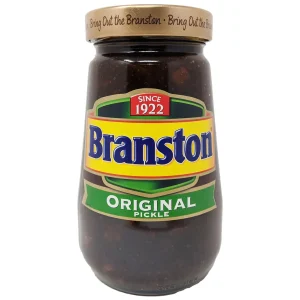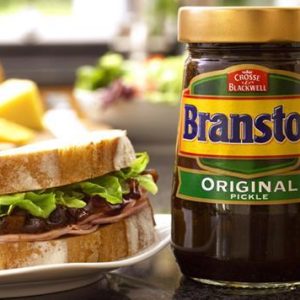Branston Original Pickle
Branston Original Pickle is more than just a condiment—it’s a jar packed with nostalgia, flavor, and cultural identity, especially for British expats living abroad. First created in 1922 in the village of Branston near Burton upon Trent, the pickle quickly became a kitchen staple in the UK. Made from a medley of chopped vegetables—carrots, cauliflower, rutabaga, onions, and gherkins—simmered in a tangy, sweet-spiced vinegar sauce, Branston’s flavor is distinct and hard to replicate. Over the decades, it’s become deeply woven into British food culture, particularly as the signature companion to cheddar in the classic cheese and pickle sandwich.
For many British expats, Branston Original Pickle isn’t just a tasty spread—it’s an emotional touchstone. Moving abroad often means adjusting to new cuisines, unfamiliar brands, and a lack of access to those little things that make home feel like home. Branston Pickle fills that gap. Its unique flavor and texture are unlike anything you can easily find elsewhere. It’s not quite chutney, not really relish—it’s a category of its own. That blend of sweet, sour, savory, and chunky makes it irreplaceable, and when it’s missing from your pantry, you really notice.
Expats often find themselves missing the simplest meals from their childhoods—things like a thick wedge of cheddar, slathered with Branston Original Pickle and sandwiched between slices of soft white bread. It might sound simple, even plain, but to those who grew up with it, it’s pure comfort food. It’s what your mum might have packed for lunch, what you grabbed from the corner shop on your way home, or what you ate in a quiet moment at a pub on a rainy day. That sandwich—made right—is incomplete without Branston. No foreign spread, no matter how fancy or gourmet, quite hits the same note.
When Brits abroad stumble across a “British shop” or an international grocery that stocks UK staples, Branston is usually right there, next to the Heinz Baked Beans, PG Tips, and Cadbury Dairy Milk. It’s part of a culinary care package that feels like a lifeline on a homesick day. And because the brand has such deep roots in British culture—it’s been referenced in TV shows, comedy sketches, even family jokes—it brings with it a flood of familiar feelings. Seeing the label alone can make someone feel instantly connected to where they came from.
Even beyond the comfort and familiarity, Branston holds up because it simply tastes good. It adds zing and depth to cold meats, livens up a plain piece of cheese, and makes sandwiches memorable. It’s not fussy, not trendy, but it’s dependable and bold. Its appeal spans generations, from grandparents to kids, all tied together by this dark brown, sticky, delicious concoction.
And while food trends have shifted and evolved, Branston has remained largely the same. The company has released new versions over the years—smooth, small chunk, spicy—but the original remains the hero. In 2013, when Mizkan, a Japanese company, acquired the brand, there were concerns about whether the recipe would change. But Branston has stuck to its roots, preserving the taste people know and love. That loyalty to tradition matters, especially when you’re far from home and craving something that feels unshakably familiar.
What’s also interesting is how Branston original Pickle carries a certain low-key cultural pride. It’s not just that people like the taste—it’s that it feels intrinsically British. Like Marmite or a roast dinner, it’s one of those foods that tells you who you are. And when you live overseas, your relationship with that identity sharpens. Suddenly, something as simple as a sandwich filling becomes a way to keep your cultural grounding. You offer a spoonful to a curious non-Brit friend and say, “This is what home tastes like.” It’s a food that explains you a little bit.
In the end, that’s what makes Branston Original Pickle such a beloved item for British expats. It’s not fancy or exclusive, but it’s deeply personal. It’s about flavor, yes—but it’s also about history, memory, and belonging. When someone spreads a thick layer of it onto bread, they’re not just making lunch. They’re recreating a piece of home.



